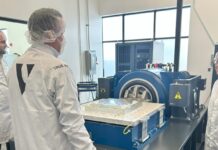The pursuit of innovation in space exploration continues to gain momentum, driven by NASA and its commercial partners. These collaborations have resulted in significant advancements that promise to enhance human spaceflight and bolster commercial efforts in low Earth orbit. Recent achievements from NASA’s industry partners highlight progress in safety, successful flight tests, and technological advancements.
Angela Hart, who manages the Commercial Low Earth Orbit Development Program at NASA’s Johnson Space Center in Houston, emphasized the importance of these developments. "Our commercial partners’ growing capabilities in low Earth orbit underscore NASA’s commitment to advance scientific discovery, pioneering space technology, and support future deep space exploration," she stated.
NASA’s collaboration with seven U.S. companies is part of the second Collaborations for Commercial Space Capabilities initiative. This initiative aims to meet future commercial and government needs by expanding opportunities in low Earth orbit.
Blue Origin’s Progress in Space Transportation
Blue Origin is making strides in developing a comprehensive commercial space transportation system. This platform aims to provide safe, affordable, and frequent access to orbit for crewed missions and other endeavors. The company’s focus on integrated space transportation systems underscores its commitment to enhancing U.S. access to space.
Northrop Grumman’s Evolving Cygnus Spacecraft
Northrop Grumman is advancing its Cygnus spacecraft to serve as a critical logistics and research platform for NASA’s upcoming low Earth orbit ventures. Recently, the company completed a project management review with NASA, outlining plans to commercialize the spacecraft. Additionally, Northrop Grumman is progressing towards implementing docking capabilities through a collaboration with Starlab Space.
Sierra Space’s Innovative Habitat Structures
Sierra Space has made significant progress in developing its LIFE (Large Integrated Flexible Environment) habitat, which is a key component of a NASA-funded commercial space station initiative. The company successfully conducted two full-scale ultimate burst pressure tests on the habitat’s structure. This inflatable habitat is designed to expand in space, providing astronauts with a flexible living and working environment. Sierra Space is also focusing on selecting materials for the habitat’s air barrier, ensuring they meet safety standards for permeability and flammability.
In addition to these advancements, Sierra Space is enhancing high-velocity impact testing and selecting materials to withstand micro-meteoroid and orbital debris. The company is also optimizing radiator designs to improve thermal management for long-duration missions.
SpaceX’s Starship Development
SpaceX continues to advance its Starship spacecraft, a fully reusable system designed for missions to low Earth orbit and beyond. The company has completed several flight tests, launching the spacecraft on the Super Heavy booster from its Starbase facility in Boca Chica, Texas. These tests demonstrated key capabilities needed for the spacecraft’s reusability, including landing burns and reentry from hypersonic speeds.
SpaceX is preparing to launch newer generations of the Starship system, featuring upgraded Raptor engines. These efforts are part of the company’s goal to operationalize the system for future crewed lunar landings under NASA’s Artemis program.
Special Aerospace Services’ Autonomous Technologies
Special Aerospace Services is developing an Autonomous Maneuvering Unit, integrating in-space servicing, propulsion, and robotic technologies. The company is assessing customer needs and defining features for the initial flight unit. Special Aerospace Services is also working on a prototype unit at its Special Projects Research Facility in Arvada, Colorado, and has begun constructing a new campus and final assembly facility in Huntsville, Alabama. These technologies aim to facilitate safer assembly, servicing, retrieval, and inspection of in-space systems.
ThinkOrbital’s In-Space Welding Innovations
ThinkOrbital has successfully demonstrated autonomous welding in space, validated by NASA and the European Space Agency (ESA). The company plans to further test in-space welding, cutting, and X-ray inspection technologies on an upcoming mission. ThinkOrbital’s third mission, slated for late 2025, will focus on developing commercially viable products, including a robotic arm with advanced end-effector solutions and standalone X-ray inspection capabilities. These in-space welding technologies could enable the construction of larger structures for future commercial space stations.
Vast’s Commercial Space Station Development
Vast is progressing in developing the Haven-1 commercial space station, which is scheduled for launch in 2025. The company has completed several technical milestones, including fabricating key components such as the primary structure pathfinder, hatch, battery module, and control moment gyroscope. Vast also conducted a solar array deployment test and completed the station’s preliminary design review with NASA’s support. The company is collaborating with NASA on developing and testing the station’s dome-shaped window, ensuring it meets rigorous pressure safety standards.
NASA’s Collaboration with Small Businesses
NASA is partnering with two businesses through its Small Business Innovation Research Ignite initiative, focusing on commercially viable technology ideas aligned with the agency’s mission needs. These companies are developing technologies for potential use on the International Space Station and future commercial space stations.
Canopy Aerospace is working on a new manufacturing system to improve ceramic heat shield production, also known as thermal protection systems. The company has validated the properties of a low-density ceramic insulator using an alumina-enhanced thermal barrier formulation. Canopy Aerospace is also developing a 3D-printed, low-density ablator for thermal protection during extreme heating. The company is exploring other 3D-printed materials, including aluminum nitride and oxide ceramic products, which could have applications across various sectors such as energy and aerospace. Additionally, Canopy Aerospace has developed standard layups of fiber-reinforced composites and integrated cork onto composite panels.
Outpost Technologies has successfully completed a high-altitude flight test of its Cargo Ferry, a reusable cargo transportation vehicle. The company tested its recovery system and range capabilities by dropping a full-scale prototype from 82,000 feet using a weather balloon. A key innovation is a robotic paraglider that guides the vehicle to a precise landing. The paraglider was deployed at an unprecedented altitude of 65,000 feet, marking a record for such systems. During the test, the vehicle autonomously traveled 165 miles before being safely recovered, demonstrating its reliability. Outpost Technologies’ low-mass re-entry system aims to protect payload mass and volume for future space cargo return missions and point-to-point delivery.
NASA’s strategy in low Earth orbit microgravity builds on the agency’s vast human spaceflight experience to advance future scientific and exploration goals. As the International Space Station approaches the end of its operational life, NASA plans to transition to a new low Earth orbit model to continue leveraging the benefits of microgravity. Through commercial partnerships, NASA seeks to maintain its leadership in microgravity research and ensure continued benefits for humanity.
For more information about NASA’s low Earth orbit microgravity strategy, visit: NASA’s Low Earth Orbit Microgravity Strategy.
For more Information, Refer to this article.


































